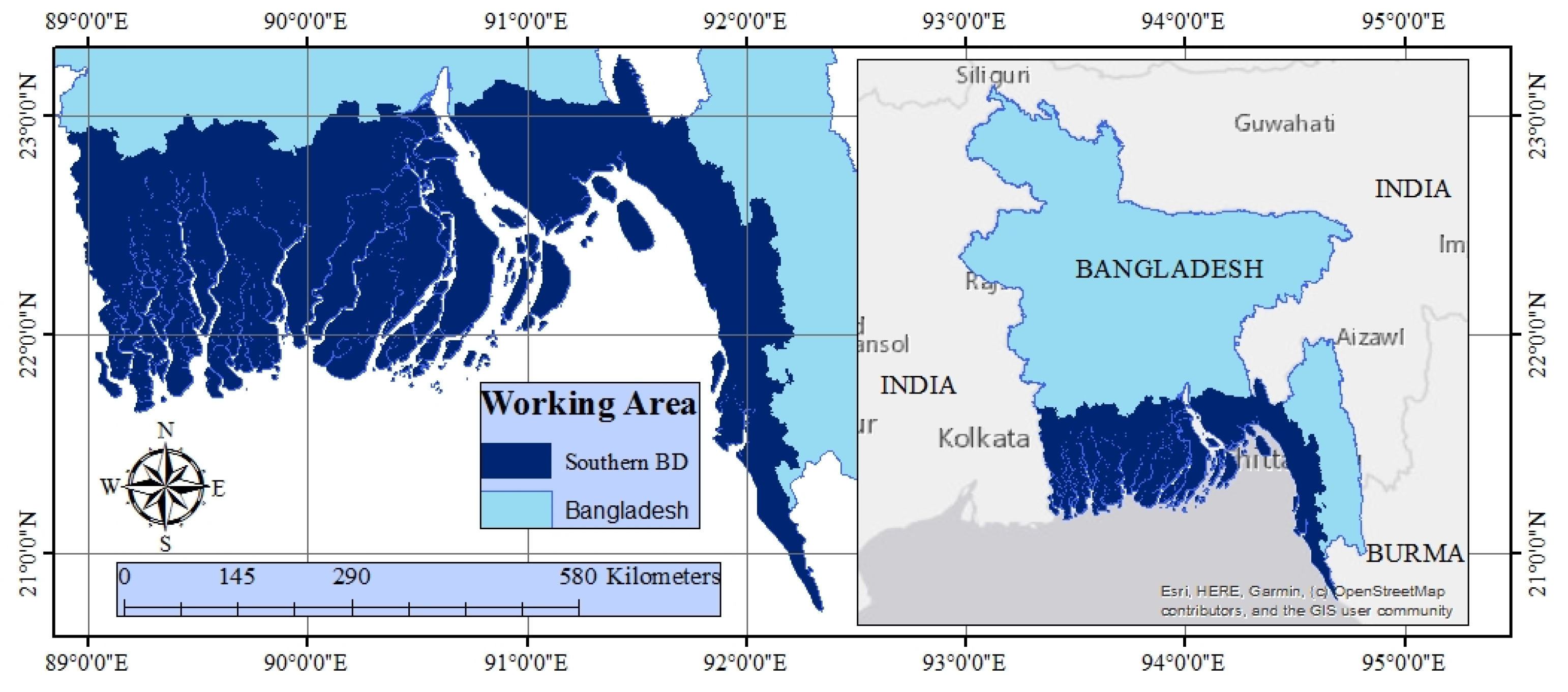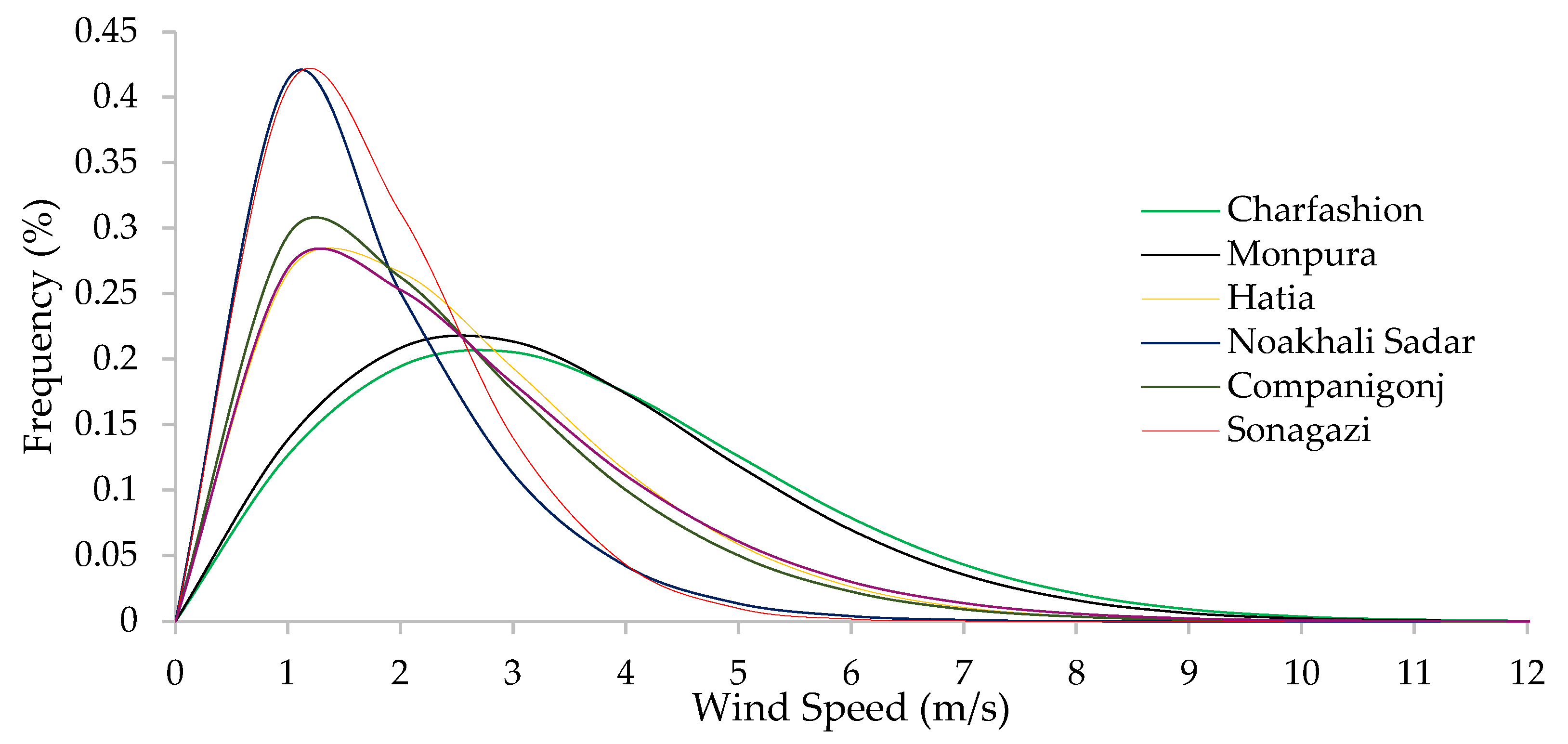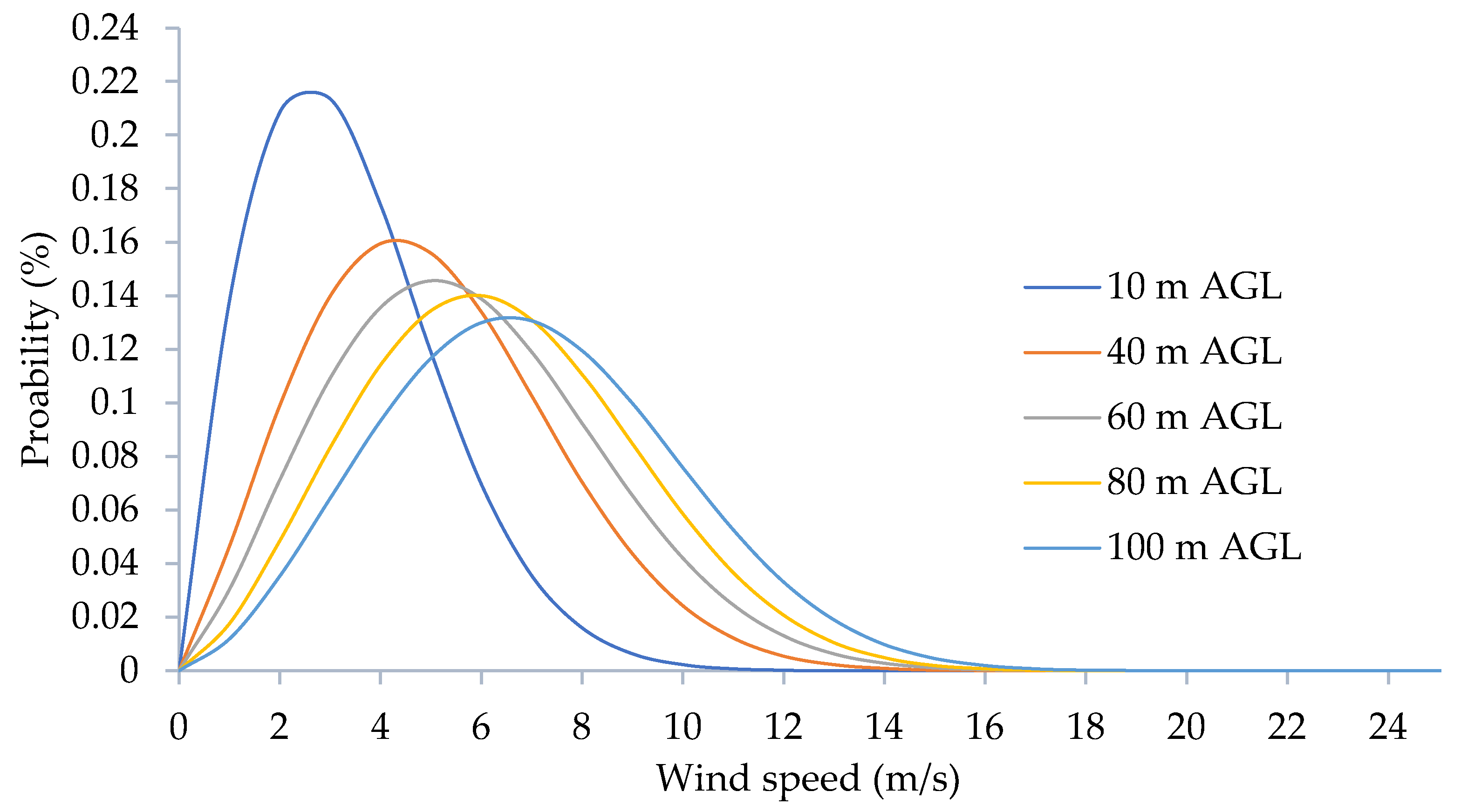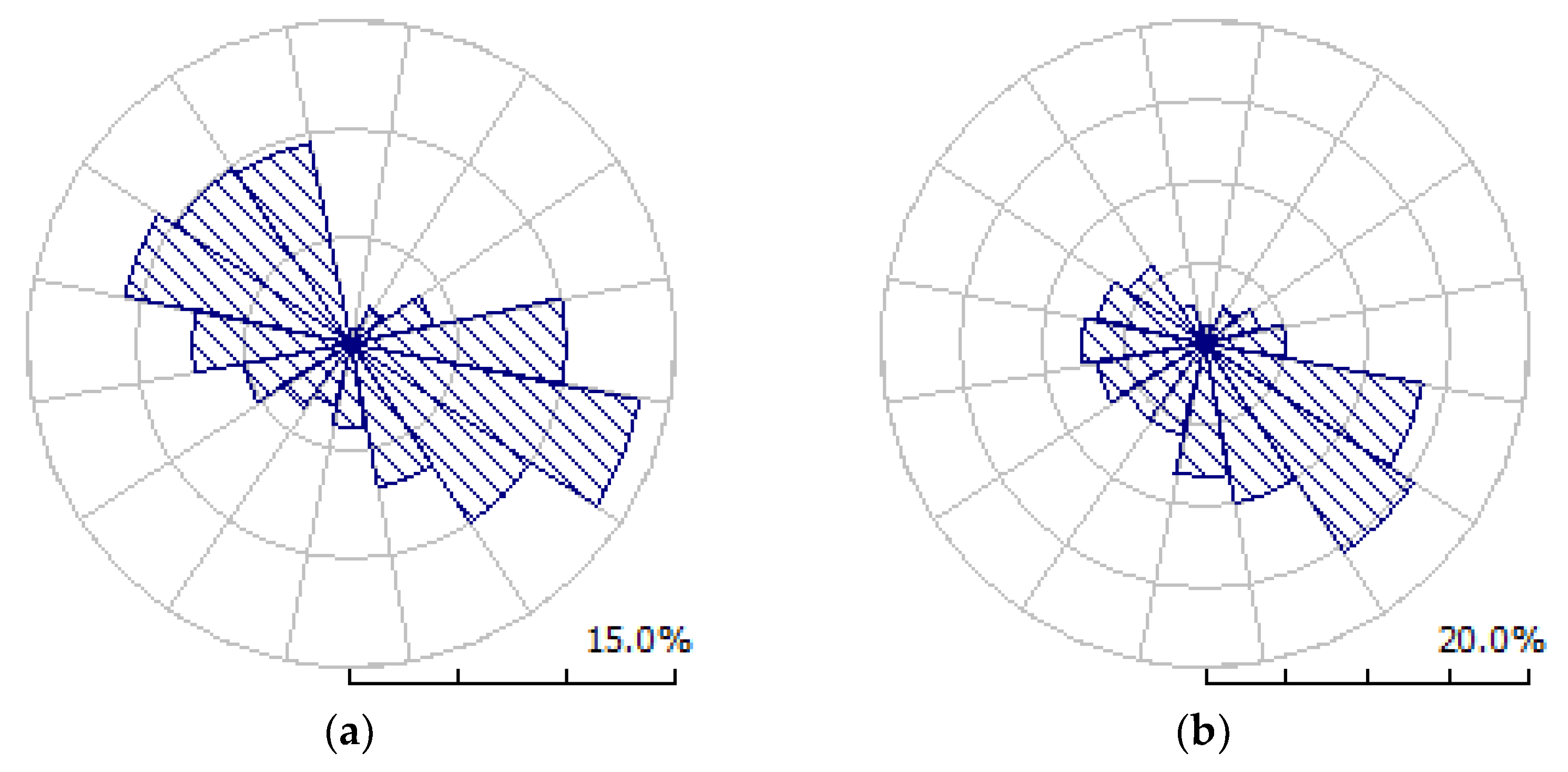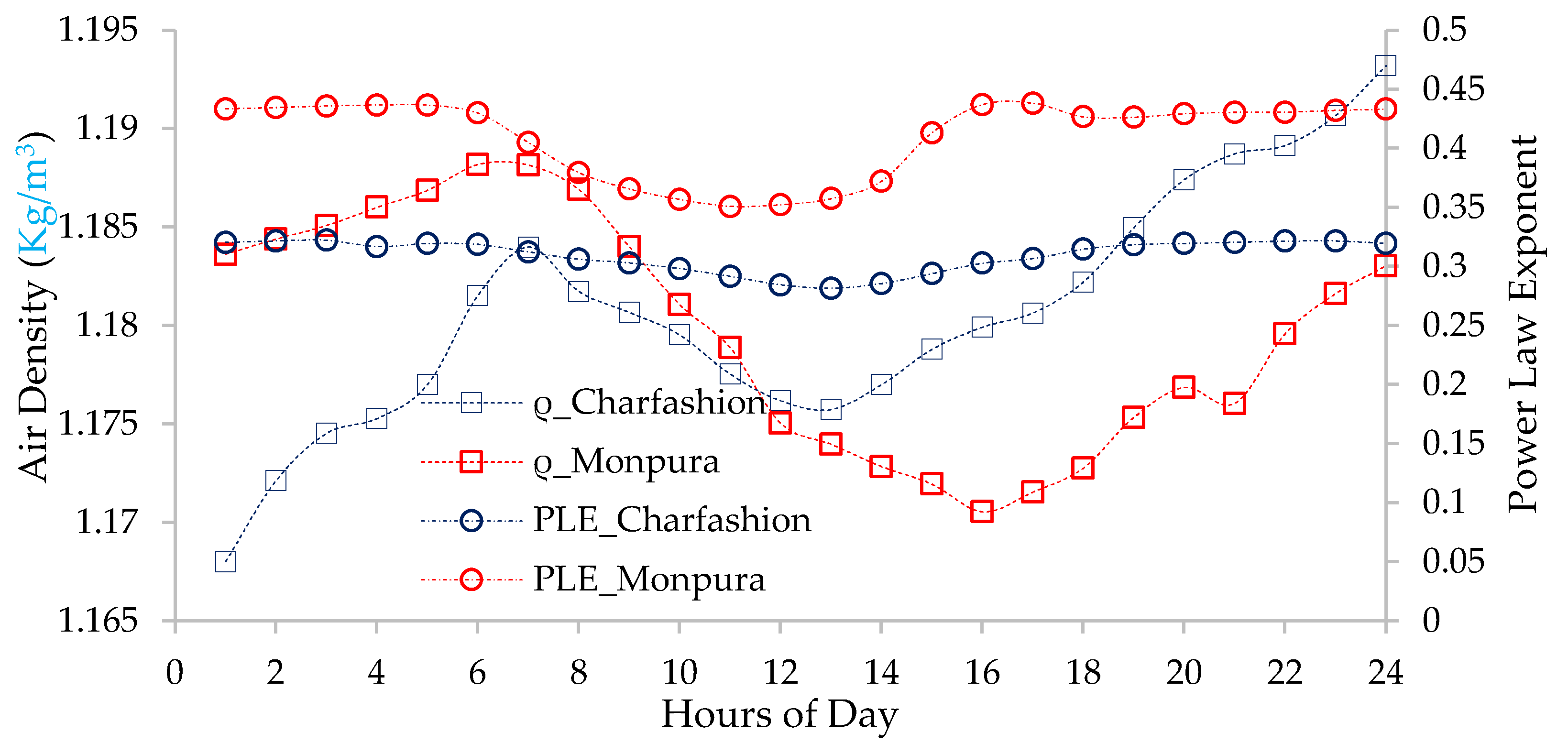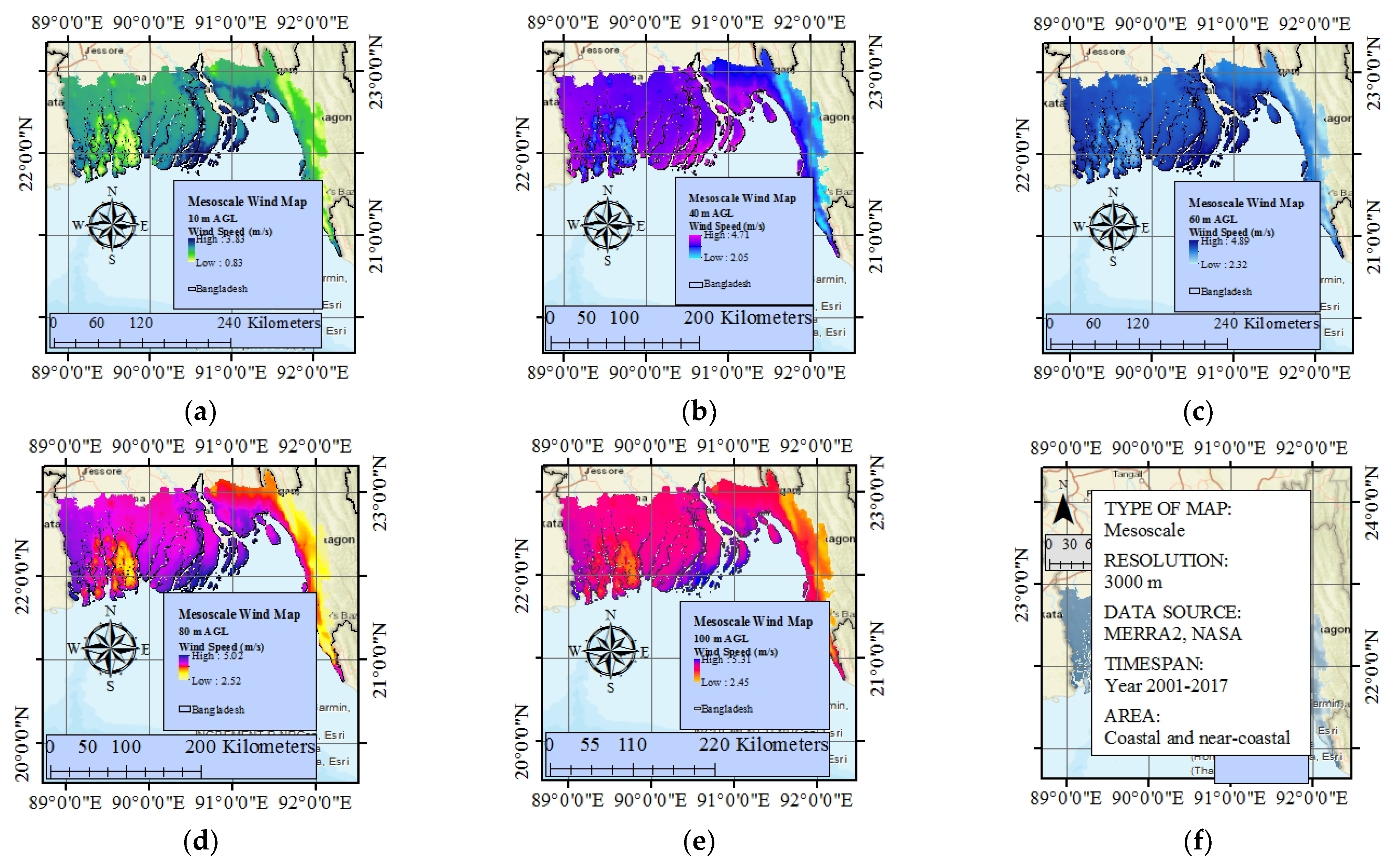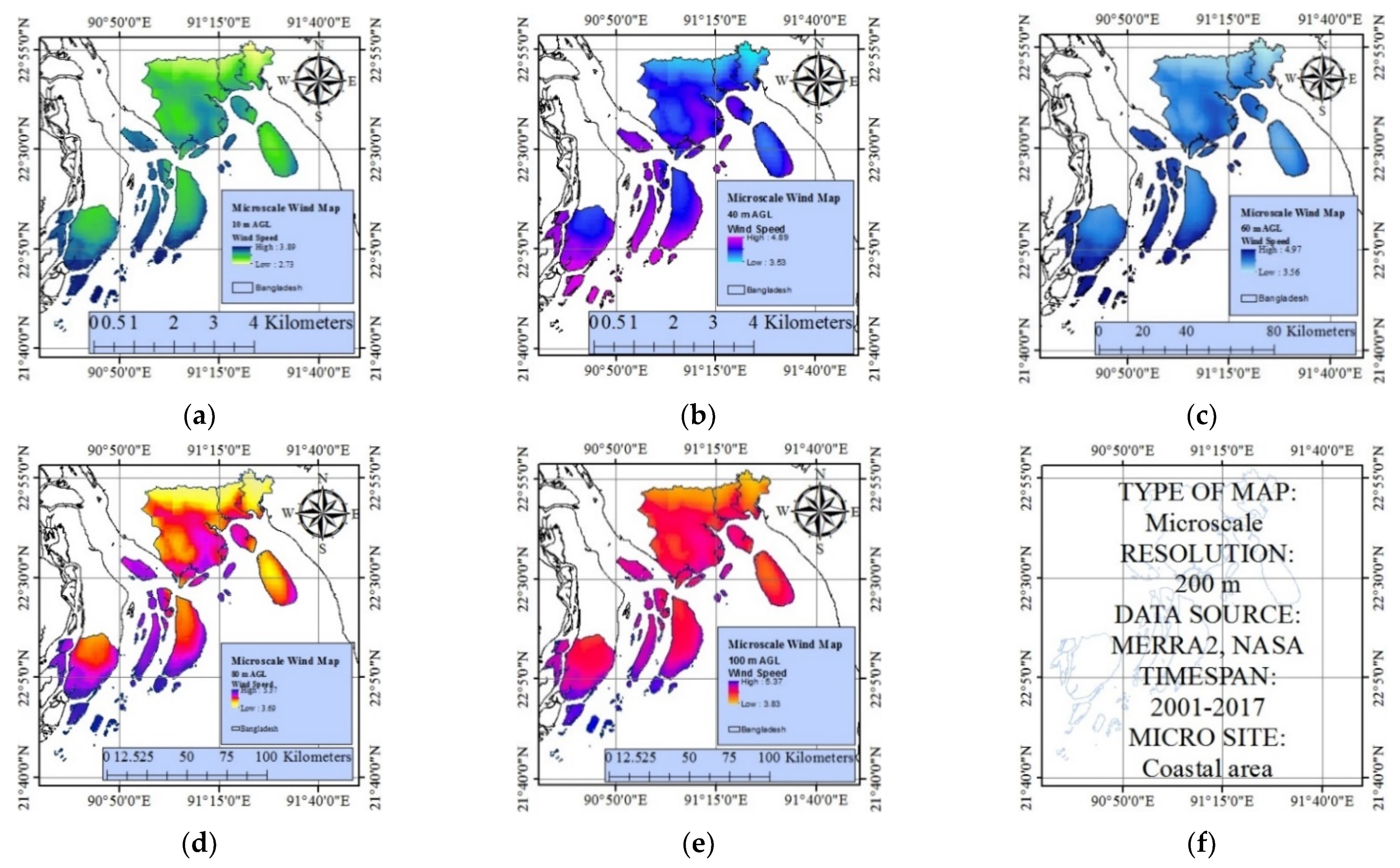This study incorporated the most well-recognized and suitable tools and methods. The related mathematical models, along with mapping techniques, are presented in this section.
2.2. Vertical Extrapolation
A suitable mathematical model was used to calculate the wind speeds at different altitudes above ground. For this purpose, the power law profile, along with regression analysis, were used to compute the wind speeds. This section describes the Hellman’s power law profile, which is the most well-recognized and commonly used mathematical formulae to determine the value of the power law exponent α that correlates wind speed at two different levels of altitude. Wind speed data are usually measured from the meteorological stations at a specified height, although other wind speed data are recorded at an unknown height, which is needed to estimate a required height. The exponent of Hellmann’s power law α is shown in Equation (1) [
9,
10].
From Equation (1), the required wind speed
v2 at a specified height
z2 can be calculated, and the new equation looks like Equation (2).
Wind speed
v2 at any specified and desired height can be predicted using Equation (2), where
v1 is the reference wind speed (m/s),
z1 is the reference height (m), and
z2 is the height where
v2 is calculated. The value of the power law exponent can again be computed using Equation (3) [
11].
In addition, α also can be estimated using Equation (4).
where
vref is the reference wind speed (
v1 in Equation (1)) and
zref is the reference height (
z1 in Equation (2)). The 1/7 power law explicitly uses 0.143 as the value of α, which is sometimes used even though it is not practical for offshore wind. The 1/7 power law usually yields conservative yet reasonable wind power estimates in situations where the roughness length for the projected sites is at least an order of magnitude smaller than the height of the reference level [
12]. For offshore wind energy potential analysis, 1/9 is usually recommended for the power exponent value, as it has been found that under neutral stability conditions, the power law exponent value of 0.11 (1/9) provides a good approximation [
13]. However, wind speed over different types of roughness of land cannot be estimated accurately using this method. As a result, the power law exponent needs to be estimated from the real wind speed data and other related information if available. However, for the current analysis, α was estimated using Equation (3), as both the reference wind speed
vref and the reference height
zref are known because the reference wind speed is the measured wind speed at a specified height.
2.3. Distribution Function
Wind data collected from meteorological stations usually recorded at 10 m AGL are illustrated by the most well-recognized distribution function of wind speed
v, called the Weibull model, which is characterized by two parameters—the Weibull shape parameter
k and the scale parameter
C [
14,
15]. Wind speed data distributed as a function of the Weibull probability distribution function (PDF) use Equation (5) [
16].
The shape and scale parameters of the Weibull PDF are measured using Equations (6) and (7) [
17].
where
k is the Weibull shape parameter,
vm is the mean wind speed shown in simple terms in Equation (8), and
σ is the standard deviation of the wind data, which can be calculated using Equation (9) [
17].
where
vm is the mean wind speed,
vi is the mean hourly wind speed, and
N is the number of measured hourly wind speed data. However, for wind energy calculation, the wind speed is weighted for its power content and is calculated using Equation (10) [
17].
The average wind speed from Equation (10) at 10 m AGL needs to be converted to the wind speed at a desired height above ground level using the power exponent law. The wind power density is calculated by considering the calculated air density value in kg/m
3 from Equation (11) [
18].
where
P is the wind power,
ρ is the air density measured in kg/m
3,
A is the wind turbine rotor swept area, and
v is the mean wind speed. Consequently, power density estimation is carried out using Equation (12).
The air density is calculated as shown in Equation (13) that uses the ideal gas law equation from the combinatorial relationship of Boyle’s Law, Charle’s Law, and Gay-Lussac’s Law, similarly to Equation (12) [
19].
where
B is the measured 10 min averaged air pressure,
ρ is the derived 10 min averaged air density, and
T is the measured 10 min averaged absolute air temperature, all of which were measured in S.I. units for this equation to work, using the value of 287.05 J/(kg
−1K) as a gas constant of dry air
Rd.
These data need to meet the requirements prescribed by IEC 61400-12-1 standard shown in
Table 1. In fact, the wind data in the current research were analyzed based on IEC 61400-12-1, because it gives an international standard of the investigation of wind energy in order to promote international cooperation that is concerned about the standardization of the energy fields. If sensors for air temperature and humidity are used, those shall be installed within 10 m of hub height, as prescribed by IEC 61400-12-1 (2017) [
20]. The mean wind speed and power density should be measured in terms of both the rule of weighted average and cubic average as per international standards.
Assessing the economic feasibility for the installation of a WTG for the generation of power,
AEP is determined as shown in Equation (14) [
21].
The
AEP produced from a WTG is estimated using the power curve of the respective WTG with the help of the frequency of hour of the measured data using the method of bin, the most prominent method for interpreting frequency distribution where the wind data are sorted by the discrete group into some wind speed intervals (usually intervals of 0.5 or 1 m/s). For each bin of the interval, the frequency of the wind speed is counted and then calculated to find the average wind speed. Once the annual energy of one year from the frequency distribution is estimated, the capacity factor (CF) can be calculated using Equation (15) [
22].
where
AEP is the annual energy production in kWh/year, 8760 is the number of hours in a year,
vci is the cut-in wind speed of the wind turbine,
vco is the cut-off wind speed of the wind turbine,
Pt is the power output curve of the wind turbine,
N is the number of wind turbines, and
CR is rated capacity. The CO
2 emissions can be estimated from
AEP using the country-wise carbon emission factor from the simple and straightforward Equation (16) [
23].
where
GHGe is the estimated reduction in greenhouse gas emissions in tons of CO
2 per year,
EF is the country-wise emission factor in g/kWh, and
AEP is the annual energy production in kWh/year.
2.5. Validation of the Wind Resource Atlas
To validate the predicted map results, the simulated wind speed data of the map were compared to the measured wind speed. As part of the validation process, several statistical tests were performed. The measured vs. predicted ratio (
M/P) is the simplest test, which is shown in Equation (17). Derivation of the percent mean relative error (
PMRE) for the simulated wind speed is shown in Equation (18).
where
Oi and
Pi denote the observed data and predicted data, respectively. In addition to the measurement of the performance, the root mean square error (RMSE) was also used, the expected value of which should be close to zero, and is expressed [
25,
26] in Equation (19).
where
Oi and
Pi are the observed and predicted wind speed respectively, both measured in m/s, and
n is the number of wind data. In addition to the statistical tests, the measure–correlate–predict (MCP) method, a very useful tool by which the predicted wind speeds are correlated with the measured wind speeds, was utilized.
